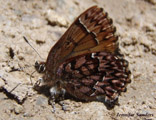Native Plants
Search for native plants by scientific name, common name or family. If you are not sure what you are looking for, try the Combination Search or our Recommended Species lists.
Pinus contorta
Pinus contorta Douglas ex Loudon
Lodgepole Pine, Beach Pine, Pino De San Pedro Martir
Pinaceae (Pine Family)
Synonym(s):
USDA Symbol: PICO
USDA Native Status: L48 (N), AK (N), CAN (N)
Lodgepole pine or beach pine is a small pine that grows quickly to 20 ft. and may reach from 30 - 150 feet at maturity, depending on variety. It has a crooked, windswept, dense habit and dark-green needles. Mature bark is red-brown and scaly. Cones are small, numerous and slow to open. Widely distributed pine that may grow tall with narrow, dense, conical crown, or remain small with broad, rounded crown; 3 geographic varieties.
Lodgepole Pine is one of the most widely distributed New World pines and the only conifer native in both Alaska and Mexico. Its name refers to the use by American Indians of the slender trunks as poles for their conical tents or teepees. Shore Pine (var. contorta), the Pacific Coast variety, is a small tree with spreading crown, thick, furrowed bark, short leaves, and oblique cones pointing backward, opening at maturity but remaining attached. Sierra Lodgepole Pine (var. murrayana (Grev. & Balf.) Engelm.), of the Cascade Mountains of southwestern Washington and western Oregon, the Sierra Nevada of central California, and south to northern Baja California, is a tall, narrow tree with thin, scaly bark, relatively broad leaves, and symmetrical, lightweight cones opening at maturity and shedding within a few years. Lodgepole Pine or Rocky Mountain Lodgepole Pine (var. latifolia Engelm.), of the Rocky Mountain region, is a tall, narrow tree with thin, scaly bark, long needles, and cones often oblique and pointing outward. This variety is adapted to forest fires, often with cones that remain tightly closed on the trees many years until a fire destroys the forest. When the heat causes the cones to open, the seeds fall to the bare ground to begin a new forest. This variety is also able to reproduce without fire, and in some areas most of the trees release their seeds without the heat of fire.
Plant Characteristics
Duration: PerennialHabit: Tree
Leaf Retention: Evergreen
Leaf Arrangement: Fascicled
Leaf Complexity: Simple
Leaf Shape: Linear
Breeding System: Flowers Unisexual , Monoecious
Fruit Type: Cone
Size Notes: Up to about 150 feet tall. Some varieties much shorter.
Leaf: Green
Bloom Information
Bloom Color: YellowBloom Time: Jun
Distribution
USA: AK , CA , CO , ID , MT , NV , OR , SD , UT , WA , WYCanada: AB , SK
Native Distribution: Coast from northern Baja California in the south to Alaska in the north
Native Habitat: Low elevation, coastal areas
Growing Conditions
Water Use: MediumLight Requirement: Sun
Soil Moisture: Dry
CaCO3 Tolerance: High
Soil Description: Rocky soils.
Conditions Comments: Beach pine is not particularly drought tolerant. It is fast growing and tolerates salt spray, high winds and sterile dune soils.
Butterflies and Moths of North America (BAMONA)
|
Western Pine Elfin (Callophrys eryphon)  Larval Host |
Propagation
Description: Easily propagated by seed.Seed Collection: Older, unopened cones will release their seeds if stored in a warm, dry place.
Seed Treatment: Pretreatment is usually not necessary, but germination of seeds exhibiting dormancy can be hastened by 1 month cold stratification.
Commercially Avail: yes
Find Seed or Plants
Find seed sources for this species at the Native Seed Network.
View propagation protocol from Native Plants Network.
National Wetland Indicator Status
| Region: | AGCP | AK | AW | CB | EMP | GP | HI | MW | NCNE | WMVE |
| Status: | FAC | FAC | FACU | FAC |
From the National Organizations Directory
According to the species list provided by Affiliate Organizations, this plant is on display at the following locations:Native Seed Network - Corvallis, OR
Bibliography
Bibref 1186 - Field Guide to Moths of Eastern North America (2005) Covell, C.V., Jr.Bibref 1185 - Field Guide to Western Butterflies (Peterson Field Guides) (1999) Opler, P.A. and A.B. Wright
Search More Titles in Bibliography
Web Reference
Webref 3 - Flora of North America (2014) Missouri Botanical Garden, St. Louis, MO & Harvard University Herbaria, Cambridge, MA.From the Archive
Wildflower Newsletter 1984 VOL. 1, NO.4 - Lady Bird Heartened by Progress, Horticultural Society Annual Meeting Held, Dire...Additional resources
USDA: Find Pinus contorta in USDA PlantsFNA: Find Pinus contorta in the Flora of North America (if available)
Google: Search Google for Pinus contorta
Metadata
Record Modified: 2022-10-07Research By: TWC Staff